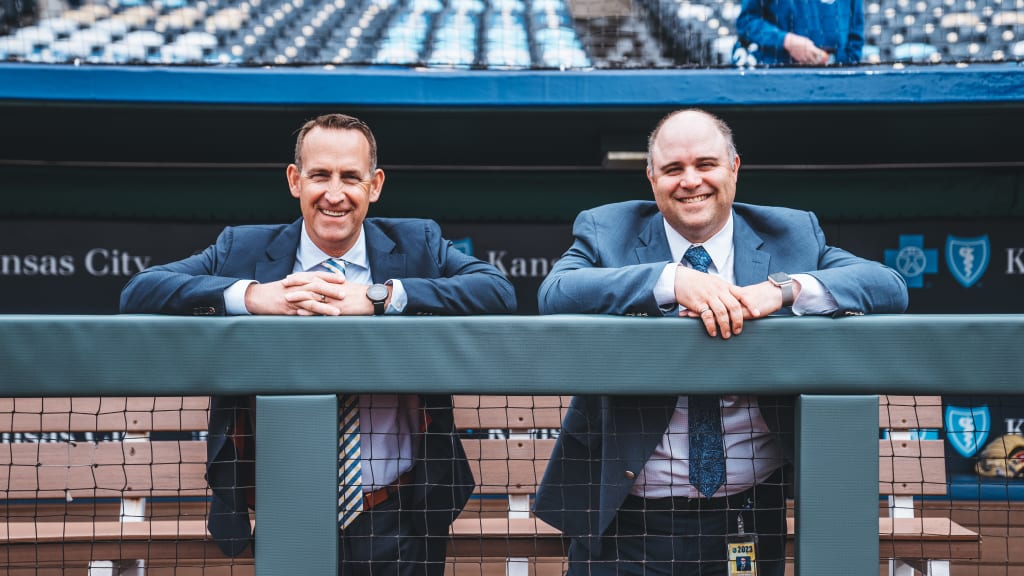
Royals assistant general managers Scott Sharp (left) and Dr. Daniel Mack (right). Photo courtesy of Jason Hanna/Royals
This story was excerpted from Anne Rogers’ Royals Beat newsletter. To read the full newsletter, click here. And subscribe to get it regularly in your inbox.
KANSAS CITY -- A major priority for the 2023 Royals has been making more data-driven decisions and integrating their research and development team more heavily with the Major League team.
I caught up with Dr. Daniel Mack, the Royals’ assistant general manager/research and development, about what this year has been like for him and his group of 11 developers and analysts -- a group that he expects to grow this offseason with new full-time positions and opportunities for internships. Here is some of our conversation, edited for length and clarity:
MLB.com: I know the process isn’t a one-season fix, but how do you feel like it’s gone this year as we head into the offseason?
Mack: I think we’ve established a really solid pipeline of communication of information from the coach to the player. We understand where we need to continue to go on that. The roadmap is quite extensive. We’re covering it quickly, but there’s a lot to go through. The offseason is going to be an awesome opportunity for us to continue to take the steps that we took in Spring Training and during the season and address things we realize were kind of bottlenecks. And also make sure we’re getting even more information to the players. That’s one of the big priorities I have.
We’ve almost completely revamped our internal system in the last eight months. It’s radically different. Our developers have done an insane amount of work. They’ve put us in a really good spot for us to continue to develop in that space.
MLB.com: Can you elaborate more on providing players with information? How much do they want, and how much is available to them compared to years’ past?
Mack: I definitely think there’s a feeling that when a player asks a question about their data, it’ll be met with, ‘If we can’t get it for you right now, we will get it for you very quickly.’ That’s allowed more guys to feel comfortable asking for that information throughout the year. Whether or not they want it all the time is a different story, and that’s player-to-player, but it’s increased quite a bit. Their access to information has also increased. Now, we’ve got to make sure it’s consistent throughout our entire organization. Players up here have access to a wide variety of systems to get to their data and are encouraged to see it and understand it.
... We began the process of installing Hawk-Eye last year in [Double-A] Northwest Arkansas because Major League Baseball installed it at Triple-A. So we have two Hawk-Eye tracking systems at two different levels. I finished the contract last week for us to get it in [High-A] Quad Cities and [Single-A] Columbia, plus biomechanical information around the system at this point.
MLB.com: What does that open up for you?
Mack: Going along the lines of what we’ve had to build for the Major League staff, a lot of those concepts, reports and visualizations will be flowing down to lower levels. So you get this consistent and coherent vocabulary. A player putting on a Columbia jersey won’t be surprised to see similar things at every spot along the way until they arrive at Kauffman. That, to me, is a big deal. It’s one of the fundamental things I really believe in. Part of the job of R&D is to help players not experience the jarring effect of information overload at this level when performing up here is an absolute premium. We want them to start understanding that information and those numbers when they’re at the lower levels, and part of that is a consistent tracking system across every level.
MLB.com: You’ve mentioned several changes and upgrades that your group has made to your internal system this year. Has there been a conversation this year that has opened your eyes to something that you hadn’t put as much thought into yet?
Mack: I think we’ve gotten a better understanding of some of the things with baserunning. We have an opportunity to create some things that weren’t necessarily brought to us like, ‘Hey, this is what we’re looking for,’ but through conversations, we’ve figured out things to be able to produce information that can better help [first base/outfield and baserunning coach] Damon [Hollins] prepare. There are some really good cutoffs, like pitcher times and pop times, and that’s always been an algorithm. But baserunning has always been more feel-oriented.
Now, we’re better understanding of where those borderlines really are and give us a better shot for some guys. To give Bobby [Witt Jr.], who is always going to be able to steal bases, a better shot. Or to help Michael Massey reach his ceiling. Especially as a club that has so many of our own young hitters, anything we can do to help them maximize their abilities is a big deal for us. We’ve got to win on the margins.
MLB.com: Is there anything else that has really stuck out to you this year?
Mack: This has been a year for us to really go from building good things, knowing where our opportunities are and making the most of those to, ‘We want to help in every different facet of the game.’ And the Major League coaching staff is completely showing what that type of relationship can look like across the organization. We’re going to continue to use that as a good pattern for how to keep growing our tools, reports and data infrastructure for every level. It’s extremely exciting.
Anne Rogers covers the Royals for MLB.com.
